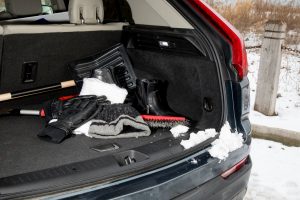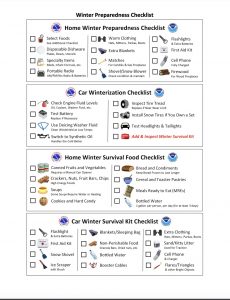Preparing for winter weather as cold and snow arrive
November 18, 2022
Being prepared for winter doesn’t have to cost a lot of money or take a lot of time. It could be as simple as adding a winter survival kit to your car.
Winter weather in Illinois may be inevitable, but being prepared will help you handle whatever weather hazards Mother Nature throws our way this year.
Knowing what to do before a disaster strikes can provide peace of mind and ultimately impact our recovery process.
To help Illinois residents be prepared for winter weather this year, the Illinois Emergency Management Agency (IEMA) and the National Weather Service (NWS) developed Winter Weather Preparedness Guide to help you and your family prepare for and stay safe during winter weather. (www2.illinois.gov/iema/Preparedness/Documents/winter_storm_preparedness_guidebook.pdf)
Preparing for winter also means adjusting your driving habits. Snowy or ice-coated roads and reduced visibility due to fog or blowing snow results in thousands of motor vehicle crashes every year in Illinois.
Many of these crashes can be avoided by slowing down on city streets, rural roads and highways. Recent traffic studies have shown that many times, minor accumulations of snow or ice on roads can be just as dangerous for motorists as major snowstorms.
This Winter Weather Preparedness Guide includes information about winter travel safety guidelines, winter weather terminology and tips to prepare your vehicle and home for winter storms.
Proper home heating is also a critical issue during the winter months, and over time has proven deadly for many families. Every year, more than 400 people die in the U.S. from accidental carbon monoxide (CO) poisoning.
According to the Centers for Disease Control (CDC), approximately 20,000 people in the U.S. visit the emergency department each year due to accidental CO poisoning. CO is found in fumes produced any time you burn fuel in cars or trucks, small engines, stoves, lanterns, grills, fireplaces, gas ranges, or furnaces. CO can build up indoors and poison people and animals who breathe it. Use this winter weather preparedness guide to educate your family about the dangers associated with this home heating hazard.
Keep in mind, being prepared for winter doesn’t have to cost a lot of money or take a lot of time. It could be as simple as making sure your vehicle is in good winter driving condition, adding a winter survival kit to your car, changing your furnace filter at home and stocking or updating your family’s emergency supply kit.
Take time now to prepare your family, home, vehicles and driving habits for everything from a dusting of snow to a major winter storm.

(Courtesy of National Weather Service)
Your Home Emergency Kit
- Use sand to improve traction and apply products that melt ice on walkways
- Make sure you have sufficient heating fuel. Regular fuel sources may be cut off
- Keep emergency heating equipment and fuel so you can keep at least one room of your house warm enough to be livable
- Keep fire extinguishers on hand, and make sure your family knows how to use them.
- Winterize your home to extend the life of your fuel supply. Insulate walls, attics, doors, and windows.
- Install storm windows or cover windows with plastic.
- Do not overexert yourself or work outside for extended periods of time.







